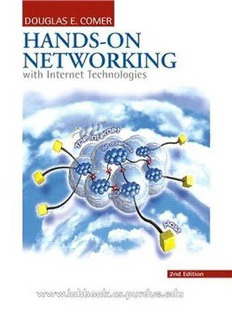
Hands-On Networking with Internet Technologies PDF
Preview Hands-On Networking with Internet Technologies
Hands-On Networking with Internet Technologies SECOND EDITION This page intentionally left blank Hands-On Networking with Internet Technologies SECOND EDITION DOUGLAS E. COMER Department of Computer Sciences Purdue University West Lafayette, IN 47907 Web site by W. DAVID LAVERELL Upper Saddle River, New Jersey 07458 Library of Congress CataIoging-in-Publication Data CIP DATA AVAILABLE. Vice President and Editorial Director, ECS: Marcia Horton Publisher:Alan Apt Associate Editor: Toni Holm Editorial Assistant: Patrick Lindner Vice President and Director of Production and Manufacturing, ESM: David W. Riccardi Executive Managing Editor: Vince O’Brien Managing Editor: Camille Trentacoste Production Editor: Irwin Zucker Manufacturing Manager: Trudy Pisciotti Manufacturing Buyer: Lisa McDowell Director of Creative Services: Paul Belfanti Creative Director: Carole Anson Art Director: Heather Scott Cover Designer: John Christiana Cover Art: KJA-Artists.com Executive Marketing Manager: Pamela Hersperger Marketing Assistant: Barrie Reinhold © 2005, 2004, 2002 by Pearson Education, Inc. Pearson Prentice Hall Pearson Education, Inc. Upper Saddle River, New Jersey 07458 All rights reserved. No part of this book may be reproduced. in any format or by any means, without per- mission in writing from the publisher. Pearson Prentice Hall® is a trademark of Pearson Education, Inc. The author and publisher of this book have used their best efforts in preparing this book. These efforts include the development, research, and testing of the theories and programs to determine their effectiveness. The author and publisher make no warranty of any kind, expressed or implied, with regard to these programs or the documentation contained in this book. The author and publisher shall not be liable in any event for incidental or consequential damages in connection with, or arising out of, the furnishing, performance, or use of these programs. TRADEMARK INFORMATION: Company and product names used in this text may be trademarks or registered trademarks of the individual companies, and are respectfully acknowledged. UNIX is a regis- tered trademark of The Open Group in the U.S. and other countries. Microsoft Windows is a trademark of Microsoft Corporation. Solaris is a registered trademark of Sun Microsystems, Incorporated. Red Hat is a registered trademark and RPM is a trademark of Red Hat Incorporated. Linux is a registered trademark of Linus Torvalds. Printed in the United States of America 10 9 8 7 6 5 4 3 2 1 ISBN 0-13-148696-9 Pearson Education Ltd., London Pearson Education Australia Pty. Ltd., Sydney Pearson Education Singapore Pte. Ltd. Pearson Education North Asia Ltd. Hong Kong Pearson Education Canada Inc., Toronto Pearson Educación de Mexico, S.A. de C.V. Pearson Education—Japan, Inc., Tokyo Pearson Education—Malaysia Pte. Ltd. Pearson Education Inc., Upper Saddle River, New Jersey For Those WhoWantAnIn-Depth UnderstandingOfComputer Networking This page intentionally left blank Contents Preface xix Chapter1 IntroductionAndOverview 1 1.1 TheFundamentalNeedForALaboratory 1 1.2 TheSpectrumOfPossible Lab Facilities 1 1.3 AWordAbout Simulation 3 1.4 Organization Of TheBook 4 Part I: A Single Computer Chapter2 HardwareAndSoftwareOnASingleComputer 7 2.1 TheTwo TypesOfSupport AndTheir Uses 7 2.2 Support ForNetwork Access 7 2.3 Support ForNetwork Programming 8 2.4 Recommendations 8 2.5 Summary 8 Chapter3 ExperimentsUsingApplicationPrograms 9 3.1 Using ASingle ComputerTo ExperimentWith Applications 9 3.2 Using AComputerTo DevelopAndTest Network Applications 9 3.3 Stress Testing Applications With AnEmulatedInternet 10 3.4 Transport Protocol DevelopmentOnASingle Computer 13 3.5 Summary 13 Experiment3.1: Use telnetto contactafortune server 15 Experiment3.2: Use telnetto contactawebserver 17 Experiment3.3: Use telnetto sendanemailmessage 19 Experiment3.4: Use theping program 21 Experiment3.5: Download anduseapacketcapturetool 23 viii Contents Part II: Network Programming On A Set Of Shared Workstations Chapter4 HardwareAndSoftwareForASharedWorkstationLab 27 4.1 ConsequencesOf Sharing 27 4.2 ExampleSharedLab Technologies 27 4.3 ArchitectureOfASharedLab 28 4.4 Using ASharedLab InANetworking Course 28 4.5 BroadcastDomainAssumption 29 4.6 Summary 29 Chapter5 NetworkProgrammingExperimentsUsingASimplifiedAPI 31 5.1 Introduction 31 5.2 Obtaining Software ForThe API 32 5.3 Summary 33 Experiment5.1: Compile, test, and extendexampleechosoftware 35 Experiment5.2: Compile, test, and extendexamplechatsoftware 37 Experiment5.3: Build asimplefile transfer service 39 Chapter6 NetworkProgrammingExperimentsUsingTheSocketAPI 41 6.1 Introduction 41 6.2 Information About Sockets 41 6.3 ANote About The Difficulty OfSocketProgramming 42 6.4 Summary 42 Experiment6.1: Compile, link,andrun asocketprogram 43 Experiment6.2: Write anechoclientandserverusing sockets 45 Experiment6.3: Build awebserverusing sockets 47 Experiment6.4: Build alibrary for a networkAPI 49 Chapter7 ConcurrentNetworkProgrammingExperiments 51 7.1 Introduction 51 7.2 Summary 52 Experiment7.1: Build aconcurrentserver(threads) 53 Experiment7.2: Build aconcurrentfile transfer server(processes) 55 Experiment7.3: Build amultiserviceserver 57 Contents ix Chapter8 ProtocolDesignExperiments 59 8.1 Introduction 59 8.2 Stress Testing Protocols 59 8.3 InternetEmulation With AGateway 59 8.4 Emulation Behavior 60 8.5 GatewayDetails 61 8.6 GatewayRegistration Message 61 8.7 PacketExchange 62 8.8 Error Processing 64 8.9 GatewaySemanticsAndDefaults 64 8.10 Possible Extensions 65 8.11 Summary 65 Experiment8.1: Build aninternetemulationgateway 67 Experiment8.2: Design aclocksynchronization protocol 69 Experiment8.3: Design areliable data transfer protocol 71 Experiment8.4: Design asliding window protocol 73 Experiment8.5: Debug anapplication protocol 75 Chapter9 ExperimentsWithProtocolsFromTheTCP/IPSuite 77 9.1 Introduction 77 9.2 Difficulties AndRewards 77 9.3 Summary 78 Experiment9.1: Build aclientfor theTIMEprotocol 79 Experiment9.2: Build aDNS client 81 Experiment9.3: Build aDHCPclient 83 Part III: Measurement And Packet Analysis On Augmented Workstations Chapter10 HardwareAndSoftwareForAnAugmentedSharedLab 87 10.1 TheIdealMeasurementLab 87 10.2 AlternativesTo AnIsolatedNetwork 87 10.3 Augmentation 88 10.4 ProtectingTheProductionNetwork 88 10.5 Computers OnAPrivateNetwork 89 10.6 Summary 89
